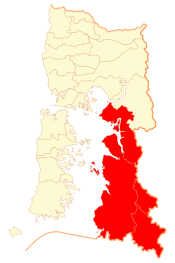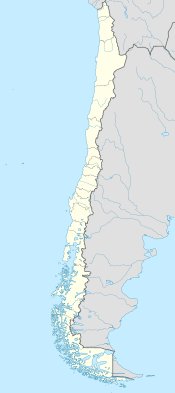Palena Province facts for kids
Quick facts for kids
Palena Province
Provincia de Palena
|
||
|---|---|---|
|
||

Location in the Los Lagos Region
|
||
| Country | Chile | |
| Region | Los Lagos | |
| Capital | Futaleufú | |
| Communes | Chaitén Futaleufú Hualaihué Palena |
|
| Government | ||
| • Type | Provincial | |
| Area | ||
| • Total | 15,301.9 km2 (5,908.1 sq mi) | |
| Population
(2012 Census)
|
||
| • Total | 16,137 | |
| • Density | 1.05457/km2 (2.73134/sq mi) | |
| • Urban | 7,624 | |
| • Rural | 11,347 | |
| Sex | ||
| • Men | 10,255 | |
| • Women | 8,716 | |
| Time zone | UTC-4 (CLT) | |
| • Summer (DST) | UTC-3 (CLT) | |
| Area code(s) | 56 + 65 | |
| Website | Government of Palena | |
Palena Province (called Provincia de Palena in Spanish) is the southernmost part of Chile's Los Lagos Region. People sometimes call it Continental Chiloé or Northern Patagonia. This is because many geographers see Palena Province as the start of Chilean Patagonia. This huge area stretches south all the way to Tierra del Fuego.
Palena Province is a remote and beautiful place. It can be tricky to reach. It is one of the least populated provinces in Chile. Its amazing geography includes steep fjords, wild rivers, hot springs, and many snow-capped volcanoes. Chile's main highway, the Austral Highway (Carretera Austral), does not go all the way through Palena Province. Drivers need to take two ferries across fjords to cross the province.
In the past, Chaitén was the capital city of the province. But the Chaitén Volcano erupted, destroying the town. So, in March 2009, Futaleufú became the new capital.
Some popular places to visit in Palena Province are Pumalín Park, Yelcho Lake, and the Futaleufu River. Pumalín Park is one of the biggest protected wilderness areas in the world. It was the dream of Douglas Tompkins, an American who loved nature. The park is now called Pumalín Douglas Tompkins National Park. It has great places for camping. Yelcho Lake is famous for fly fishing. The Futaleufu River is known as one of the best places in the world for whitewater rafting.
Palena Province is sometimes called Continental Chiloé (Chiloé Continental). This is because it is located right across from Chiloé Island. The province gets its name from Palena Lake. The lake was named by Nicolás Mascardi, an Italian Jesuit, after a town called Palena in Abruzzo, Italy.
Contents
How Palena Province is Governed
Palena is a province, which is a type of administrative area. It is managed by a provincial governor. The president chooses this governor.
Local Government: Communes
The province is divided into four smaller areas called communes. Each commune has its own local government, called a municipality. An alcalde (mayor) leads each municipality.
Land and People of Palena Province
A study in 2002 by the National Statistics Institute (INE) gathered information about the province. It found that Palena Province covers an area of 15,301.9 square kilometers (about 5,908 square miles).
The population was 18,971 people. This included 10,255 men and 8,716 women. This means there were about 1.2 people per square kilometer. Palena is the seventh least populated province in Chile. About 7,624 people (40.2%) lived in towns, while 11,347 people (59.8%) lived in rural areas. Between 1992 and 2002, the population grew by a small amount, about 1.2%.
See also
 In Spanish: Provincia de Palena para niños
In Spanish: Provincia de Palena para niños



